
Explore the Seo Chong Ho Hydropower Station – built as a testament to Sino-Vietnamese cooperation, this station illuminates not just the local grid but also the lives of communities it serves.
The Seo Chong Ho Hydropower Project situated in Lào Cai province in the northwest region of the country bordering China’s Yunnan province, was Việt Nam’s first foreign-invested hydropower project.
In October 2006 the two countries established the Vietnam – China Power Investment Co Ltd as a joint venture to deliver the power station project. The project was jointly funded and constructed by China South Power Grid Yunnan International Co Ltd (49% share) and Vietnam Electricity Northern Power Corporation (51% share).
The project kicked off in 2008 and on December 18, 2012, the Seo Chong Ho Hydropower Plant was connected into Việt Nam’s national power grid and was officially put into operation on December 28, 2012. Construction of a Phase II Expansion Project commencing on June 29, 2021 which was put into operation on June 28, 2022, increasing the annual power generation by about 12 percent.
The plant initially comprised of two turbines with installed capacity of 21.7MW, and a designed power output of 99,420 million KWh of electricity a year, and a third turbine was added in Phase II expansion.
At 1,677 meters above sea level in northern Việt Nam’s Hoang Lien Son mountainous region, the man-made Seo My Ty Reservoir is the highest reservoir in Việt Nam and, according to the VnExpress news site, is likely among the highest lakes in Indochina. It is also has the highest water head horizontal unit in Southeast Asia, with a total water head for power generation of 863.6 meters.
Seo Chong Ho Hydropower Plant was considered the most challenging among small and medium hydropower projects in Việt Nam by Vietnamese and foreign industry developers and experts.
The project received valuable experise and support of Vietnamese and Chinese agencies and the close cooperation of its joint venture partners overcame hardships to assert its role as a responsible and dynamic investor. Thus, barriers resulting from differences in construction investment regulations of Việt Nam and China, complex terrain, severe weather and fluctuating prices of construction materials were addressed for the fastest implementation of the project.
Sources:
- Xinhua Silk Road, Dec 29, 2022. https://en.imsilkroad.com/p/332009.html
- Việt Nam Business Forum, Aug 19, 2021. https://vccinews.com/news/44754/vietnam-china-power-investment-co-ltd-scaling-up-seo-chong-ho-hydropower-plant.html
- Tuoi Tre News, January 26, 2024. https://tuoitrenews.vn/news/vietnam-life-vietq/20240126/where-is-the-highestaltitude-reservoir-in-vietnam/78030.html
- BarrettYL, Sep 11, 2024. https://youtu.be/KOrd-_N2M1Q